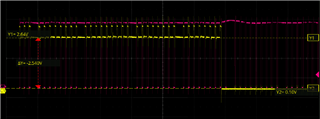Other Parts Discussed in Thread: ADC1175
When I use epi0s0-s15 to read data from two adc1175s(8Bit adc), epi0s30 is configured as CS and it connects to the adcclk pin to provide clock to both adcs. I found that maybe the IO of TM4C1294KCPDT absorbs so much current that the high level of the data signal is only 2.7V (as you can see in the pic below), and the chip becoms very hot, so i just disable the epi0s0-s15, and configure them to gpio input , then it get normal, the high level of the data signal is 3.3V again.
I don't know why it happened, the data received is correct when i use epi read , it's just too hot, may reach 90 degrees Celsius quickly.
those are my code to configure the EPI as Host-bus 16bit mode:



